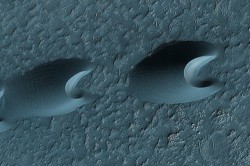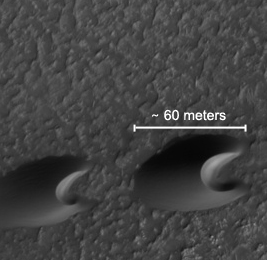There seems to be a never-ending flow of stunning images coming from the High Resolution Imaging Science Experiment (HiRISE) on board NASA’s Mars Reconnaissance Orbiter (MRO). In today’s high-resolution look at the Martian surface, large flat-topped hills (a.k.a. mesas) can be seen to be eroded by the Mars winds, stripping them of their material, creating sand dunes downwind. An incredible sight, it shows just how dynamic and powerful the Martian winds really are…

Imaged above the Hellespontus region of Mars, these fluid-like structures trailing across the surface are huge sand banks and sand dunes, built up after years of erosion from mesas upstream. The Mars winds have gradually stripped the large geological structures, allowing sand to build up as dunes in areas of calm. The curious crescent/droplet-shaped dune morphology indicates dominant winds blowing from west to east (left to right). As sand is carried from the mesa, it travels downstream. Where the winds begin to slack, possibly in large turbulent eddies; the suspended sand is dropped to allow dunes to grow.
The shapes of the Mars dunes bear a striking resemblance to barchan dunes, much like the ones found on Earth. The wind blows up the gentle slope of the dune, allowing sand to gradually build up. As the sand reaches a critical point, it collapses, forming a sharp slope on the downwind-facing side. Horn-like features are evident from above. In addition to the barchans, “seif”-like dunes are evident. Seifs are longitudinal stretches of sand parallel to wind direction. These are most obvious as they trail away from the mesas and stretch toward the clusters of barchan dunes.
See the entire region in a full-resolution projection.
These new images were captured on March 16th and resolve features to approximately 1.5 meters. At this level of resolution the small ripples in the wind blown sand can even be seen. To give an idea of scale, I’ve included a close up of one of the dunes. As annotated, the larger dunes are approximately 60 meters in length (from east to west) and around 40 meters in width.
Source: HiRISE




You got me, was in a rush getting this out – all corrected now, cheers 🙂
Ian
“An incredible site” – possibly, but should be ‘sight’
“the Mars dunes bare a striking resemblance” should be ‘bear’
It’s a pity for bad spelling to spoil an otherwise good article.
Thanks Dave, much appreciated 😀 Glad you are enjoying the articles, there’s loads more where this came from…
Cheers, Ian
I’m sure that some of that sand is scoured from that mesa, but I’ve seen very similar formations happen around my house when it snows – it’s called drifting.
Well Andy, how many articles have you published with your perfect spelling?
Good article Ian, I enjoyed it and appreciate your efforts. I subscribe to Sky & Telescope and Astronomy magazine, Your articles fit right in as it is impossible for monthly pubs to list all that is happening now.
I have put this message up on the HIRISE web site:
Image PSP_007676_1385 is shown as a illustration of sand dunes, but I feel the most significant features are the two Ice Mounts at the bottom of the image where the sun is shining on the sides and lighting them up. They are not craters, they are raised ridges of ice. I suggest they are a completely new feature, a form of ice volcano where the underlying water is forcing its way to the surface and creating a flat topped circular feature; a round hill if you like. Now, look at the bottom edges of those two hills and they show blue ice and if that is true then the other features in the image that look like sand dunes may instead be ice features caused by the wind creating circumstances that allow the otherwise frozen water vapour, like you get from freeze drying, to form such solid features on the surface.
But the most important part is that if you have an ice volcano on the surface, you have liquid water under the surface…… Food for thought?
the third picture down from the top is great. it will be my desktop for the next little while.